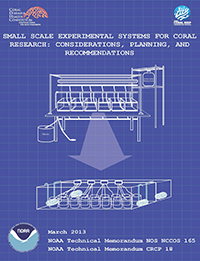-
Home
-
Data & Publications
-
Regional Portals
- About Regional Portals
- Florida
- Navassa Island
- Puerto Rico
- Flower Garden Banks
- U.S. Virgin Islands
- American Samoa
- Commonwealth of the Northern Mariana Islands
- Federated States of Micronesia
- Guam
- Main Hawaiian Islands
- Republic of the Marshall Islands
- Northwestern Hawaiian Islands
- Republic of Palau
- Pacific Remote Island Areas
-
CRCP Activities
- Glossary
Small Scale Experimental Systems for Coral Research: Considerations, Planning, and Recommendations

Only a few decades ago, keeping coral alive and healthy in closed, captive systems proved to be challenging. However, by the mid-1980s several breakthroughs were made and success with captive systems became more commonplace. In the short time since, there has been a surge of interest, knowledge, and technological advances with significant contributions from marine science, the aquarium industry, and aquarium hobbyists. Currently, there are several strategies for maintaining live coral outlined in many books, articles, and online resources. The majority of information now available focuses on success in either home and public aquaria (for aesthetic purposes) or commercial production.
Likewise, the difficulty in keeping coral in captivity has limited their use in well controlled laboratory experimentation. Much of the research on coral health and disease has been observational (vs. manipulative), and until recently, experimentation has been performed in a field setting which is subject to many uncontrollable variables, some measurable and some not. Furthermore, experimentation with infectious agents of coral diseases and toxicant effectors (i.e., chemical or biological agents eliciting a response) in the wild carries the risk of harming natural populations and raises ethical dilemmas. As a result of these issues, we and others are working to create laboratory life support systems for corals that can be used for experimentation under well controlled and monitored parameters. This is in contrast to the hobbyist or public aquaria approaches that focus on enhancing aesthetic properties (i.e., color, feeding behavior etc.) rather than approximating optimal physiological condition of the coral. Laboratory life-support systems strive to control as much variability as possible thus providing greater statistical power (i.e., the ability to detect significant differences from collected data).
In the following technical memorandum, techniques and procedures are presented to assist researchers in developing small experimental systems for coral and attempts to identify possible confounding factors to consider when setting up laboratory experiments with coral. The system features presented here are intended for relatively simple experiments when funding, space, and time (i.e., experimental duration from days to one or two months) are limiting. While focused on scleractinian coral, often referred to as stony or hard coral, the following information can be applicable to studies involving other cnidarian model organisms, such as anemones (Order Actiniaria) or soft coral (Order Alcyonacea).
Citation: Bartlett, T.C. 2013. Small Scale Experimental Systems for Coral Research: Considerations, Planning, and Recommendations. NOAA Technical Memorandum NOS NCCOS 165 and CRCP 18. 68pp.
Small Scale Experimental Systems for Coral Research: Considerations, Planning, and Recommendations (full report, pdf, 4.98 MB)
For more information, contact:


